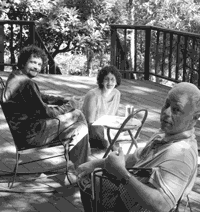Blog
Subscribe
Join over 5,000 people who receive the Anecdotally newsletter—and receive our free ebook Character Trumps Credentials.
Categories
- Anecdotes
- Business storytelling
- Collaboration
- Communication
- Corporate Storytelling
- Culture
- Decision-making
- Employee Engagement
- Events
- Fun
- Insight
- Leadership Posts
- News
- Podcast
- Selling
- Strategy
Archives
- April 2024
- March 2024
- December 2023
- November 2023
- October 2023
- September 2023
- August 2023
- July 2023
- June 2023
- May 2023
Years
Digital Habitats—book review
 Digital Habitats: Stewarding Technology for Communities by Etienne Wenger, Nancy White and John D. Smith
Digital Habitats: Stewarding Technology for Communities by Etienne Wenger, Nancy White and John D. Smith
I’m often the technology steward for communities of practice (CoP). I create the Ning spaces and configure ‘em, I setup the email lists, I work out whether we should have a wiki or a blog or a discussion forum or some other combination of communication technologies. As you can see I’m quite a geek: I really do love it.
And whenever I get stuck I’ll contact my friends at CPSquare: Etienne, Nancy and John. And while I know they all have a deep understanding of CoPs I tend to ask Etienne the theory questions, Nancy the technology questions and John the group dynamics questions. Together they are a formidable team. Sadly I think their new book, Digital Habitats, will give them strong cause to suggest I should RTFM: Read The Flipping Manual.
Digital Habitats (DH) has a single goal: to help the reader understand the role of technology steward in cultivating a community of practice: what is it, why you would do it, are you are cut out for it, how to do it and where to find help. But it is not a shoppers guide nor a roadmap for technology selection.
There is a lovely photo of Etienne, Nancy and John in the preface and I feel that reading DH is like have a friendly conversation with them on a sunny balcony. They provide the context, a little theory, then lots of practical tips supported by real life stories to ground it and make it memorable.
For me there are three ideas in this book I have already put into practice with great effect.
Experience shows us that all know that communities of practice are different, and sometimes poles apart. DH introduces the idea of community orientations to help us understand where the emphasis might lie and therefore what technologies make most sense.
There are 9 orientations: meetings, open-ended conversations, projects, content, access to expertise, relationships, individual participation, community participation, serving a context. With my engineering communities, for example, I’ve asked the members where they see their current orientation and then ask them to identify where they would like to be. A community might start off very content focussed but realise that the real benefits will come from providing access to expertise. By understanding this orientation gap the technology steward can start introducing tools to facilitate the future orientation needs.
The second idea I find useful is how my friends (I was going to say ‘the authors’ but it didn’t feel right) describe the range of activities a community might be engaged in. The axis range from informal to formal and learning from to learning with. This diagram helps me ensure I’m thinking about the full range of possibilities when helping communities members design their CoP.
DH envisages three types of readers: deep divers, attentive practitioners and just do it-ers. The just do it-ers are directed to chapter 10 which contains an action notebook. It is a series of checklists to help you think about the role of the technology steward. What I love about chapter 10 is that I can jump in and start learning about the role by doing things and then come back to the descriptions contained in the rest of the book when it is more meaningful for me. DH makes the job of finding the relevant descriptions in the other chapters easy through a multitude of cross-links from chapter 10 to the relevant book section.
There are very few practical community of practice books available (I can think of 3 others) and Etienne has already had a hand in writing one of them. So Digital Habitats is a valuable addition to this exclusive club. It’s highly readable and practical and will definitely help make a difference to the quality of your technology support for your community of practice.
About Shawn Callahan
Shawn, author of Putting Stories to Work, is one of the world's leading business storytelling consultants. He helps executive teams find and tell the story of their strategy. When he is not working on strategy communication, Shawn is helping leaders find and tell business stories to engage, to influence and to inspire. Shawn works with Global 1000 companies including Shell, IBM, SAP, Bayer, Microsoft & Danone. Connect with Shawn on:
Comments
Comments are closed.
Thanks for the review, Shawn! I noticed something curious when your blog post turned up in a Google Alert. I wonder whether it’s something that’s set up from your end or from the Google Alert end. Anyway, this URL kind of keeps you trapped in an advertisement-laden environment that never really gets you to the meat of your comments:
http://www.feeds4all.nl/f.aspx?FeedID=113831
Seemed a bit irritating to me and an example of the very complicated wiring that connects us all.
Hmmm, I wonder how I turn that off? Does anyone know?
Thanks Shawn for the review. I heard Dr Etienne Wenger keynote speech at KM Singapore 2009 which is how I got to know about this book.
With your review, all the more reasons for me to go read it. Have a nice day.